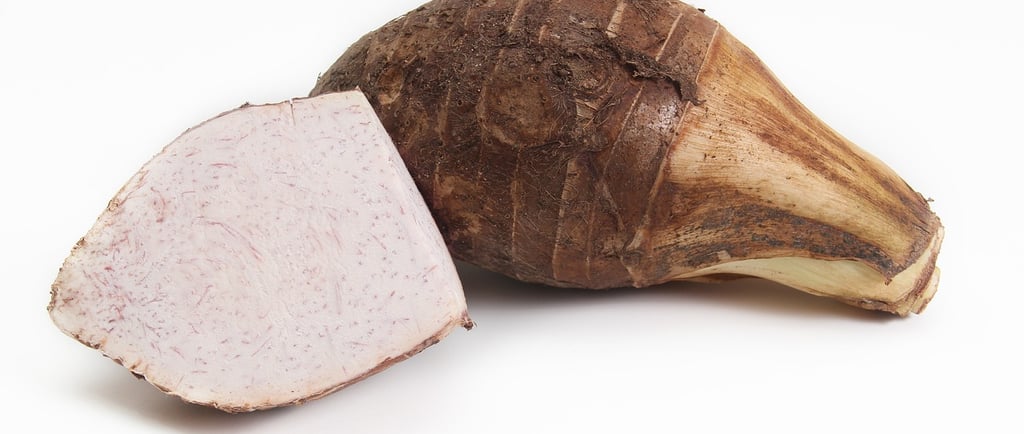Lower your risk of heart disease by including Taro in your diet
Taro, a starchy root vegetable commonly found in tropical regions, is more than just a versatile ingredient for your meals—it's also a heart-healthy addition to your diet. Rich in essential nutrients, fiber, and antioxidants, taro can play a significant role in lowering your risk of heart disease. One of the key benefits of taro is its high fiber content, which supports healthy cholesterol levels. A diet rich in fiber helps reduce the absorption of cholesterol in the bloodstream, preventing plaque buildup in the arteries—a major risk factor for heart disease. The potassium found in taro also helps regulate blood pressure, further contributing to cardiovascular health by promoting smooth blood flow and reducing strain on the heart. In addition, taro contains antioxidants like vitamin E and polyphenols that combat oxidative stress and inflammation, both of which are linked to heart disease. Its low glycemic index makes it a suitable choice for people managing blood sugar levels, as it causes a slow, steady rise in blood sugar rather than sharp spikes. By incorporating taro into your meals, whether through stews, soups, or roasted dishes, you can enjoy a delicious and nutritious way to support your heart health. As part of a balanced, heart-healthy diet, taro offers a natural, plant-based option for reducing your risk of cardiovascular disease.
LIFESTYLE
11/17/20245 min read


Prevent heart disease by including taro in your day-to-day meals and plans. Lower your risk of heart disease by incorporating more fiber rich foods, like taro, into your diet. Do these words ring a bell? Family meal? Don't we always love them? They were full of laughter and good food. But then of course, there’s always the problem of heart disease. Many families have fear of it because of the fact that it is one of the health problems in the US. But what if a secret root vegetable called taro is the solution? It’s effective with nutrients and has taro health benefit that can make a difference.
In what way can they include Meals with taro to prevent heart disease? Hence, it will show how to prevent or control heart disease with the help of this healthy root. This prompts us to make better hearts choices when it comes to food.
Key Takeaways
· Taro offers vital nutrients that contribute to heart health.
· Know the cause of diseases to be able to prevent them.
· Taro incorporated into foods can be fun and effortless.
· Another cardiovascular advantage of high dietary fiber in Taro is its cholesterol-lowering effectiveness.
· Taro’s antioxidants are said to prevent heart diseases.
· Find yummy ways how to include taro in your dietary plan.
Understanding Heart Disease
Heart diseases comprise a wide array of related conditions, those dysfunctions the heart. It makes it difficult for the heart to pump oxygenated blood throughout the body. Examples include coronary heart disease and heart failure.
Having knowledge on heart ailments is useful in maintaining the health of anyone’s heart.
Many things can increase your risk of heart disease. High blood pressure, high cholesterol, being overweight and not moving enough are some. Your genes and age also matter. Symptoms can be different, like chest pain, shortness of breath, or feeling tired.
It is also wise, not wise but highly intelligent, to make any move even at a terribly early stage. Changing one’s stamina can help lower the heart disease or at best, prevent it. This is further supported by CDC, Mayo clinic and the National Heart, Lung and Blood Institute.
What is Taro?
Taro root is a starchy underground part of the plant grown over thousands of years. It is mostly found in the tropical and subtropical regions. Taro, which originates in South East Asia and its Pacific Islands is considered as one of the staples in many cuisines. This has a pale purple flesh with creamy consistency which provides various health benefits.
The health benefits of taro root fit into the bodies very well. It contains a lot of potassium, which is important for controlling blood. There are also vitamin E which is an antioxidant that is useful for the skin. Additionally, there is also a high amount of dietary fiber in the taro which is good for the digestive system.
The plant is water loving and thus cannot survive in drier climate areas, rather a warm moist climate is needed. For such a reason, most of the taro is grown in the wet areas in terms of rainfall.
They harvest the tubers months later in order to maximize their quantity. Taro has an acquired taste in that it is similar to yam or potatoes with a difference.
To put it briefly, taro is not just delicious and adaptable in dishes. It is wholesome as well. This is the reason why one can incorporate this in safe meals.
Taro Heart Disease Nutrition Health Benefits Root Vegetables Dietary Fiber Antioxidants
It is a root vegetable where taro acts as a remedy for inner heart problems as it possesses vitamin-rich components. Abundant in dietary fiber and water-soluble antioxidants, where by elements offer great health benefits. Which these attributes demonstrates that taro is a component of recommended diet.
High Dietary Fiber Content
Taro’s dietary fiber is even more beneficial, specifically for the heart. Fiber is vital for lowering cholesterol, which decreases heart disease risk. There are also effects on the body's reaction and general overall well-being as eating people helps in the increase their level of body activity.
It has been noted that high fiber consumption is associated with reduced risk of heart diseases. Therefore, if you are searching for a portion of your meal as containing a balance d diet, then including taro recipe would be wise.
Antioxidant Properties of Taro
Antioxidants found in taro are protective against oxidative stress and inflammation that plays an important role in heart disease. The use of taro radicals protects the cells from destruction. Including this in the diet of a person is nourishing and thus averting the risk of heart disease.
How Taro Promotes Heart Health
It is considered a nutritious root that supports ‘taro heart’ facilitates healthy heart diet.
Regular consumption can protect against cardiovascular ailments. It is effective due to the high fiber content that decreases cholesterol levels hence reducing heart risks.
The other nutritional values of taro help to manage blood pressure. Taro has a lot of potassium, which makes sure blood circulation is up to the standards. This mineral takes away sodium helping relax the blood vessels and with that promotes heart health.
Available tocopherols, for example, the rudimentary members of vitamin E. Taro also has antioxidants that work against the body’s oxidative stress. As we all know, inflammation is a precondition for heart diseases, and chronic inflammation is usually the cause of heart attacks. Including taro in your meals will help one attain this goal. All these reasons concerning the consumption of taro are the reasons as to why it should be included in a well-balanced heart healthy diet.
How to Add Taro in Your Meals
Meals with taro will be tasty as well as healthy. The taro is perfect for lots of different meals. New and heart-healthy meals can be made with taro; blow away your heart. If you have never had taro before, have no fear, here are some simple cooking methods for you.
Try these tantalizing starts, soups and kale dishes which are rich in or include Health Benefits.
Taro Mash: A stringy free mashed taro is known as taro mash. This includes boiling and mashing the taro with butter and garlic to have fish fillet followed by a tasty side.
Taro Chips: Cut the taro into thin slices, wrap with a layer of olive oil and desired seasonings, and back for a healthy munchies.
Taro Soup: Taro is not just useful for thickening dishes, this versatile root can also be blended into a warm soup with coconut milk, some stock and vegetables.
Steamed Taro Cakes: Grate the taro into very fine particles and combine rice flour as well then prepare and serve as one of the Dim sums dishes.
Tips for Beginners
Be cautious because Taro can be quite tricky to prepare. It also comes with several nutritional health benefits. Below are some information provided regarding how to go about while cooking taro. Fresh and firm taro roots should be chosen. Cooked taro is distance in taste, and feeling to fresh taro. The taro roots constitute a member of the herbaceous plants’ family. They blend well in soups, stews and sauces and form good purees as well. Taro fattens the flesh and creaminess that improves your dishes, so don’t Taro fatten when melting to Taro first.
This may include having more Information you do not have or comprehending things in a deeper perspective. Bet these recipes will arouse your interest in cooking and will be fun. Try to eat taro regularly in your everyday meals. It will also ensure that your diet is not boring and monotonous.
